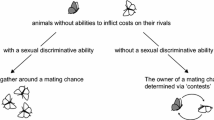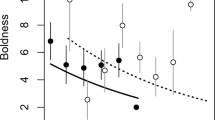Abstract
In many animals, males interact with or without physical contact to contest the possession of mating sites. The winner in such interactions often has larger body size and is the individual that previously occupied the territory (the resident). However, there is little consensus among studies on territorial insect species concerning which traits determine individual fighting ability, and why residency increases the chances of victory. We studied the butterfly Actinote pellenea to evaluate the hypothesis that stronger males are more likely to become residents, and that traits functionally related to behaviors adopted during contests should be important determinants of fighting ability. Males of A. pellenea grapple in the air and fall to the ground during combat. Therefore, we predicted that traits related to physical strength should be the most important determinants of the outcome of contests. To test our hypothesis, we observed fights between resident and intruder males, and fights in which both rivals were induced to behave as residents. We found that physical fighting was more likely when both rivals behave as residents. In addition, wing length and body mass were more closely related to contest success than age. Our results indicate that previous residency increases male motivation to fight, and that stronger individuals become residents. Although butterflies are considered weaponless, we suggest that traits important to contest resolution change according to behaviors adopted during disputes.

Similar content being viewed by others

References
Alcock J (1994) Alternative mate-locating tactics in Chlosyne californica (Lepidoptera, Nymphalidae). Ethol 97:103–115
Alcock J, Bailey WJ (1997) Success in territorial defense by male tarantula hawk wasps Hemipepsis ustulata: the role of residency. Ecol Entomol 22:377–383
Andersson M (1994) Sexual selection. Princeton University Press, Princeton
Arnott G, Elwood RW (2008) Information-gathering and decision-making about resource value in animal contests. Anim Behav 76:526–542
Arnott G, Elwood RW (2009) Assessment of fight ability in animal contests. Anim Behav 77:991–1004
Benson WW, Haddad CFB, Zikan M (1989) Territorial behaviour and dominance in some heliconiid butterflies (Nymphalidae). J Lepid Soc 43:33–49
Bergman M, Olofsson M, Wiklund C (2010) Contest outcome in a territorial butterfly: the role of motivation. Proc R Soc Lond B 277:3027–3033
Bissoondath CJ, Wiklund C (1995) Protein-content of spermatophores in relation to monandry/polyandry in butterflies. Behav Ecol Sociobiol 37:365–371
Burnham KP, Anderson DR (2002) Model selection and multimodel inference: a practical information-theoretic approach, 2nd edn. Springer, New York
Chaves GW, Patto CEG, Benson WW (2006) Complex non-aerial contests in the butterfly Charis cadytis (Riodinidae). J Insect Behav 19:179–196
Contreras-Garduno J, Canales-Lazcano J, Córdoba-Aguiar A (2006) Wing pigmentation, immune ability and fat reserves in males of the rubyspot damselfly Hetaerina americana. J Ethol 24:165–173
Core Team R (2012) A language and environment for statistical computing. R Foundation for Statistical Computing, Vienna, Austria
Deinert EI, Longino JT, Gilbert LE (1994) Mate competition in butterflies. Nature 370:23–24
Eff D (1962) A little about the little-known Papilio indra minori. J Lepid Soc 16:137–142
Freitas AVL, Benson WW, Marini-Filho OJ, Carvalho RM (1997) Territoriality by the dawn’s early light: the Neotropical owl butterfly Caligo idomenaeus (Nymphalidae: Brassolini). J Res Lep 34:14–20
Hardy ICW, Briffa M (2013) Animal contests. Cambrigde University Press, Cambrigde
Hernández MIM, Benson WW (1998) Small-male advantage in the territorial tropical butterfly Heliconius sara (Nymphalidae): a paradoxical strategy? Anim Behav 56:533–540
Irschick DJ, Herrel A, Vanhooydonck B, Damme RV (2007) A functional approach to sexual selection. Funct Ecol 21:621–626
Kelly CD (2006) Fighting for harems: assessment strategies during male-male contests in the sexually dimorphic Wellington tree weta. Anim Behav 72:727–736
Kemp DJ (2000) Contest behavior in territorial male butterflies: does size matter? Behav Ecol 11:591–596
Kemp DJ (2006) Ageing, reproductive value, and the evolution of lifetime fighting behaviour. Biol J Linn Soc 88:565–578
Kemp DJ (2013) Contest behavior in butterflies: fighting without weapons. In: Hardy ICW, Briffa M (eds) Animal contests. Cambrigde University Press, Cambrigde, pp 134–146
Kemp DJ, Wiklund C (2001) Fighting without weaponry: a review of male-male contest competition in butterflies. Behav Ecol Sociobiol 49:429–442
Kemp DJ, Wiklund C (2004) Residency effects in animal contests. Proc R Soc B 271:1707–1711
Kokko H (2013) Dyadic contests: modelling fights between two individuals. In: Hardy ICW, Briffa M (eds) Animal contests. Cambrigde University Press, Cambrigde, pp 5–32
Koskimäki J, Rantala MJ, Taskinen J, Tynkkynen K, Suhonen J (2004) Immunocompetence and resource holding potential in the damselfly, Calopteryx virgo L. Behav Ecol 15:169–173
Lailvaux SP, Irschick DJ (2006) A functional perspective on sexual selection: insights and future prospects. Anim Behav 72:263–273
Leimar O, Enquist M (1984) Effects of asymmetries in owner-intruder conflicts. J Theor Biol 111:475–491
Maynard-Smith J (1982) Evolution and the theory of games. Cambridge University Press, Cambridge, UK
Minor WC (1950) Footprints in the trail. Erle Press, Chicago
Oliveira R, Schlindwein C (2010) Experimental demonstration of alternative mating tactics of male Ptilothrix fructifera (Hymenoptera, Apidae). Anim Behav 80:241–247
Orr AG (1999) The big greasy, Cressida cressida (Papilionidae). In: Kirchng RL, Scheermeyer E, Jones RE, Pierce NE (eds) Biology of Australian butterflies. CSIRO, Canberra
Peixoto PEC, Benson WW (2008) Body mass and not wing length predicts territorial success in a tropical satyrine butterfly. Ethol 114:1069–1077
Peixoto PEC, Benson WW (2009) Daily activity patterns of two co-ocurring tropical satyrine butterflies. J Insect Sci 9:54
Peixoto PEC, Benson WW (2011) Seasonal effects of density on territory occupation by males of the satyrine butterfly Paryphthimoides phronius (Butler 1867). J Ethol 27:489–496
Peixoto PEC, Benson WW (2012) Influence of previous residency and body mass in the territorial contests of the butterfly Hermeuptychia fallax (Lepidoptera: Satyrinae). J Ethol 30:61–68
Peixoto PEC, Medina A, Mendoza-Cuenca L (2014) Do territorial butterflies show a macroecological fighting pattern in response to environmental stability? Behav Process 109:14–20
Pinheiro CEG (1991) Territorial hilltopping behavior of three swallowtail butterflies (Lepidoptera, Papilionidae) in western Brazil. J Res Lep 29:134–142
Rutowski RL (1991) The evolution of male mate-locating behavior in butterflies. Am Nat 138:1121–1139
Rutowski RL (1992) Male mate-locating behavior in the common eggfly, Hypolimnas bolina (Nymphalidae). J Lep Soc 46:24–38
Stuart-Fox D (2006) Testing game theory models: fighting ability and decision rules in chameleon contests. Proc R Soc Lond B 273:1555–1561
Switzer PV (2002) Territory quality, habitat selection, and competition in the amberwing dragonfly, Perithemis tenera (Say) (Odonata: Libellulidae): population patterns as a consequence on individual behavior. J Kansas Entomol Soc 75:154–157
Takeuchi T (2006) Matter of size or matter of residency experience? Territorial contest in a green hairstreak, Chrysozephyrus smaragdinus (Lepidoptera: Lycaenidae). Ethology 112:293–299
Takeuchi T, Honda K (2009) Early comers become owners: effect of residency experience on territorial contests dynamics in a lycaenid butterfly. Ethology 115:767–773
Temeles EJ (1994) The role of neighbours in territorial systems: when are they ‘dear enemies’? Anim Behav 47:339–350
Tyler H, Brown KSJ, Wilson K (1994) Swallowtail butterflies of the Americas. Scientific Publishers, Gainesville
Vieira MC, Peixoto PEC (2013) Winners and losers: a meta-analysis of functional determinants of fighting ability in arthropod contests. Funct Ecol 27:305–313
Waage JK (1988) Confusion over residence and the escalation of damselfly territorial disputes. Anim Behav 36:586–595
Wickman PO, Wiklund C (1983) Territorial defence and its seasonal decline in the speckled wood butterfly (Pararge aegeria). Anim Behav 31:1206–1216
Acknowledgments
We thank the Fundação José Pedro de Oliveira and Parque Estadual da Serra do Mar that permitted the field studies and the Fundação de Amparo à Pesquisa do Estado de São Paulo (Fapesp) for fellowships. We also thank Darrel Kemp, Martin Bergman, and three anonymous referees for their many important contributions.
Funding
This study was funded by the Fundação de Amparo à Pesquisa do Estado de São Paulo—FAPESP (grant number 08/52354-2R).
Author information
Authors and Affiliations
Corresponding author
Ethics declarations
Conflict of interest
The authors declare that they have no competing interests.
Ethical approval
This study was authorized by the Brazilian governmental agency called ICMBio (license 18904-1), in accordance with Brazilian environmental laws.
This article does not contain any studies with human participants performed by any of the authors.
Additional information
Communicated by D. Kemp
Electronic supplementary material
Below is the link to the electronic supplementary material.
ESM 1
(PPTX 173 kb)
Rights and permissions
About this article
Cite this article
Carvalho, M.R.M., Peixoto, P.E.C. & Benson, W.W. Territorial clashes in the Neotropical butterfly Actinote pellenea (Acraeinae): do disputes differ when contests get physical?. Behav Ecol Sociobiol 70, 199–207 (2016). https://doi.org/10.1007/s00265-015-2042-6
Received:
Revised:
Accepted:
Published:
Issue Date:
DOI: https://doi.org/10.1007/s00265-015-2042-6



